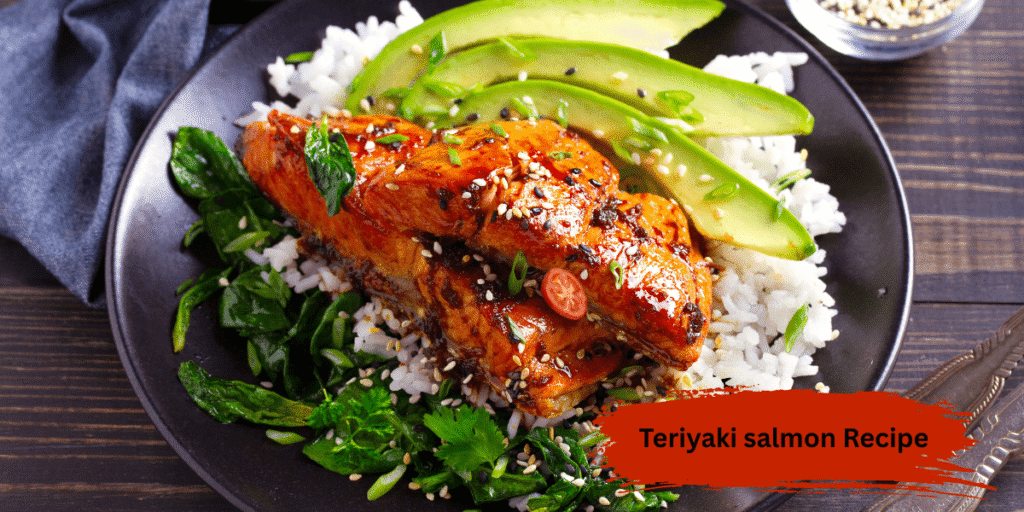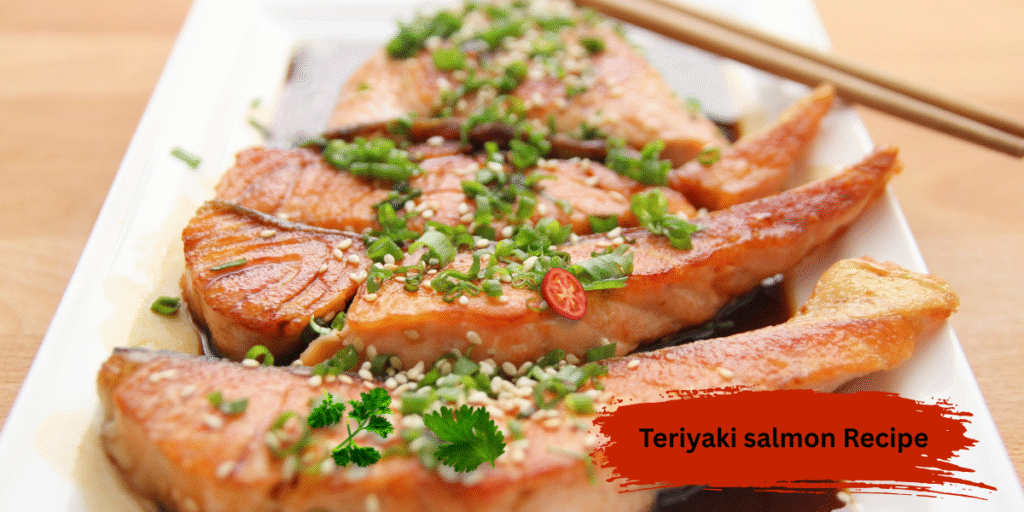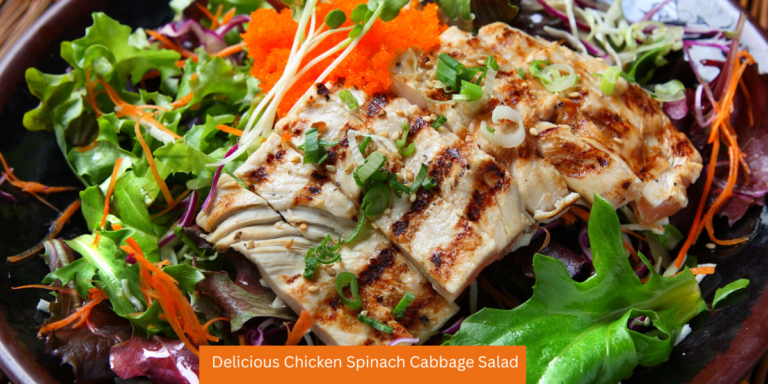Teriyaki Salmon Recipe: A Flavor-Packed Dish You’ll Love
Introduction
If you’re searching for a quick, healthy, and flavorful dinner, Teriyaki Salmon is your answer. This savory-sweet dish blends the rich umami taste of teriyaki sauce with the buttery texture of salmon, making it a must-try for seafood lovers. Whether you’re a busy home cook or trying salmon for the first time, this recipe is simple, satisfying, and sure to impress.
What is Teriyaki Salmon?
Teriyaki Salmon is a Japanese-inspired dish made by glazing salmon fillets with a sticky, slightly sweet, and savory teriyaki sauce. The salmon is typically seared, baked, or grilled until perfectly tender, allowing the glaze to caramelize beautifully.
The result? A dish that’s rich in flavor, healthy, and absolutely irresistible.

Why You’ll Love This Dish
- ✅ Quick to Make – Ready in under 30 minutes.
- ✅ Healthy Option – High in protein and omega-3 fatty acids.
- ✅ Kid-Friendly – Sweet-savory flavor loved by all ages.
- ✅ Customizable – Pair with rice, noodles, or veggies.
Ingredients for Teriyaki Salmon
To prepare this delicious dish, you’ll need:
- 2–4 fresh salmon fillets (skin-on or skinless)
- 1/4 cup soy sauce (low sodium preferred)
- 2 tablespoons honey or brown sugar
- 2 tablespoons rice vinegar
- 1 tablespoon sesame oil
- 1 tablespoon fresh ginger (grated)
- 2 garlic cloves (minced)
- 1 tablespoon cornstarch (mixed with 2 tbsp water for thickening)
- Optional: sesame seeds, green onions for garnish
How to Make Teriyaki Salmon (Step-by-Step)
Step 1: Prepare the Sauce
In a small saucepan, combine soy sauce, honey, rice vinegar, sesame oil, garlic, and ginger. Simmer on low heat for 5–7 minutes. Stir in the cornstarch-water mixture to thicken the sauce. Once thick, remove from heat.
Step 2: Cook the Salmon
Season your salmon fillets lightly with salt and pepper.
You can choose to:
- Pan-sear: Cook salmon skin-side down in a skillet with a little oil for 3–4 minutes per side.
- Bake: Bake at 400°F (200°C) for 12–15 minutes.
- Grill: Grill over medium heat for about 4 minutes per side.

Step 3: Glaze with Teriyaki Sauce
Brush or spoon the warm teriyaki sauce over the cooked salmon. Let it sit for a few minutes to soak up the flavor.
Step 4: Garnish & Serve
Top with sesame seeds, chopped green onions, or a squeeze of lemon for freshness. Serve with steamed rice, stir-fried vegetables, or soba noodles.
Best Sides for Teriyaki Salmon
- Steamed jasmine rice or brown rice
- Stir-fried bok choy or broccoli
- Cucumber salad with sesame
- Garlic noodles or soba
- Miso soup for a full Japanese-inspired meal
Tips for Perfect Teriyaki Salmon
- Don’t overcook: Salmon should flake easily but still be moist.
- Marinate for extra flavor: You can marinate salmon in teriyaki sauce for 30 minutes before cooking.
- Use fresh salmon: Fresh, high-quality fillets give the best texture and taste.
- Make it spicy: Add chili flakes or Sriracha to the sauce for a kick.
Variations to Try
- Teriyaki Salmon Bowls: Serve over rice with avocado, edamame, and pickled carrots.
- Baked Teriyaki Salmon: Bake in foil for easy cleanup.
- Air Fryer Teriyaki Salmon: Crisp outside, juicy inside, cooked in minutes.
- Teriyaki Salmon Tacos: Top with slaw and spicy mayo.
Nutrition Facts (Per Serving)
- Calories: ~350
- Protein: 30g
- Fat: 18g (mostly healthy fats)
- Carbs: 10–15g
- Rich in Omega-3s, Vitamin B12, and Selenium
Conclusion
Teriyaki Salmon is a delightful combination of flavor, nutrition, and simplicity. Whether you’re preparing a weeknight dinner or entertaining guests, this dish checks all the boxes. With just a few ingredients and easy steps, you can bring restaurant-style quality to your kitchen.
So next time you’re wondering what to make for dinner, Teriyaki Salmon is a must-try recipe that’s guaranteed to impress!
FAQs
Q1: Can I use store-bought teriyaki sauce?
Yes, but homemade gives a fresher, less processed flavor and allows you to control sugar and salt levels.
Q2: How long can I store leftovers?
Keep in an airtight container in the refrigerator for up to 3 days. Reheat gently to avoid drying out the fish.
Q3: Can I use frozen salmon?
Absolutely. Just thaw it in the fridge overnight and pat dry before cooking.
Q4: Is Teriyaki Salmon gluten-free?
Most soy sauces contain gluten. Use tamari or gluten-free soy sauce to make it gluten-free.
Q5: What’s the best way to reheat it?
Reheat in the oven at 300°F (150°C) for about 10 minutes or gently warm in a skillet.
Q6: Can I make Teriyaki Salmon ahead of time?
Yes, you can cook it in advance and store it in the fridge for up to 3 days. Reheat gently to retain moisture and flavor.
Q7: Can I freeze Teriyaki Salmon?
Yes. Cooked Teriyaki Salmon can be frozen for up to 2 months. Let it cool completely before storing in an airtight container or freezer bag.
Q8: What’s the best salmon for this recipe—wild or farmed?
Both work, but wild-caught salmon generally has a firmer texture and richer flavor, while farmed salmon tends to be fattier and more tender.
Q9: Can I make it without sugar?
Yes. You can use sugar-free substitutes like monk fruit, stevia, or a touch of pineapple juice for natural sweetness.
Q10: Is Teriyaki Salmon good for weight loss?
Yes—when served with veggies or brown rice. Salmon is high in protein and healthy fats, which help keep you full longer.
Q11: Can I grill Teriyaki Salmon on an outdoor BBQ?
Definitely! Grill over medium-high heat for 4–5 minutes per side. Use a grill basket or foil to prevent sticking and flare-ups.
Q12: What’s the difference between teriyaki sauce and soy sauce?
Soy sauce is salty and thin, while teriyaki sauce is thicker, sweeter, and includes ingredients like sugar, garlic, and mirin or vinegar.
Q13: Can I use the teriyaki sauce for other dishes?
Yes! Use it as a marinade or glaze for chicken, tofu, shrimp, beef, or vegetables. It’s a versatile sauce.
Q14: How do I make it spicy?
Add red pepper flakes, chili oil, or a spoonful of Sriracha to the sauce while cooking for a spicy kick.
Q15: What drink pairs well with Teriyaki Salmon?
Try green tea, white wine (like Sauvignon Blanc), or even a cold Japanese beer to complement the sweet-savory flavors.







